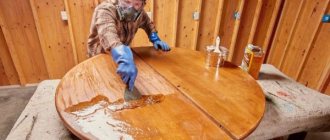What paint is suitable and is varnish needed?
There is no need to buy expensive paints to age furniture. An inexpensive water-based emulsion for ceilings is quite suitable. It dries quickly, does not cause difficulties during work and is easily mixed with colors (dyes). Choose pastel colors, giving preference to gray, blue, cream, and white shades.
Inexpensive water-based paint is quite suitable for aging furniture.
Before painting Provence style furniture, coat the surface with an acrylic wood primer. It will increase the adhesion of paint to the surface and reduce its consumption. Any pigment lies smoothly on the primer. To create an artificial patina, use bitumen varnish and silver. The first option is suitable for aging light surfaces, and the second - for dark ones. When choosing a topcoat for furniture in the Provence style, it is preferable to use matte rather than glossy varnish. It emphasizes the effect of antiquity, preserves color and texture without highlighting smudges or unevenness.
Furniture painting using decoupage technique
If you want to fill your home with new colors, try painting furniture in the Provence style. This will require only partial restoration of grandma's old cabinet. This is a rather painstaking job, during which you will have to show patience and diligence.
Many craftsmen working in the Provence style prefer to paint furniture using stencils or the decoupage method. This painting technique allows you to speed up the work process, since only small details will need to be completed. Creating an exclusive Provence style wardrobe with your own hands is not as difficult as it might seem at first glance. But you will be proud to show off your creation to your family and friends.
To paint furniture, you should use acrylic paints. They are more suitable for outdoor woodworking and have a water-resistant quality. To ensure that the design is applied without streaks, brushes should be selected from synthetic fibers. Also, during operation they will not stick together.
By painting furniture with your own hands, you can decorate a table, chair, cabinet doors and cabinets. All work consists of several stages:
1. First treat the surface with a primer. Next, apply the base paint in two layers. This will avoid streaks on the wooden surface.
2. When applying a design to a surface, use stencils. With their help, the design can be repeated several times over the entire surface. To make the resulting image match the Provence style, blow the paint with a hairdryer. This will give it a slight blur.
3. To keep the picture as long as possible, open it with varnish. Once the first layer has dried, repeat the procedure.
4. If you apply a thin layer of gold paint to the drawing, you will get the impression that the room contains antique furniture.
Important! If you rub wax on wooden furniture, it will look like it has been bleached by the sun.
On video: remodeling a door in Provence style.
Aging with paraffin and paint
For the first option for aging furniture in the Provence style, you will need the following set of materials:
- dye;
- foam sponge;
- fine-grained sandpaper;
- paraffin candle.
Before you start aging the furniture, take care to keep the workplace clean - with your own hands or with an assistant, we cover everything with newspaper so as not to stain anything. Next, we prepare the furniture for painting - remove the layer of old varnish using sandpaper, wipe the surface from dust, take out the shelves, remove the handles and rub the wood with paraffin candles. To make the process faster, use spray paint in a can. It penetrates well into hard-to-reach places and crevices. Due to the fact that it is not sprayed evenly in all places, the effect of antiquity only intensifies. Spray the paint at a distance of 50 cm from the surface.
After application, the paint must be allowed to dry
After applying the paint, let it dry slightly and treat the painted wood with the rough side of a dishwashing sponge. We do not recommend using sandpaper in this case, as it can severely damage the surface. Start by wiping off excess wax paint from the sides of the furniture and then move to the base. Movements should be easy without effort, and abrasions should be as natural as possible. If desired, the aged surface can be supplemented with painting or using the decoupage technique.
We fix the resulting effect with two layers of varnish. To create artificial cracking, apply a craquelure varnish instead of the usual matte or glossy one.
Concepts for decorating in the Provençal version
Don’t delay, try now to take some object inherited from your ancestors - an armchair, a table, a chair or a chest of drawers, and use several available methods yourself. If desired, decorating Provence is not so difficult. To process a product and create artificial aging, you must first prepare it; remove all removable elements, drawers and shelves.
Don’t delay, try now to take some object inherited from your ancestors - an armchair, a table, a chair or a chest of drawers, and use several available methods yourself. If desired, decorating Provence is not so difficult. To process a product and create artificial aging, you must first prepare it; remove all removable elements, drawers and shelves.
Let's look at several available techniques and concepts for aging furniture at home:
- Using paraffin and coloring materials, for this we need to have the following materials and tools on hand (pastel shades of paint, sponge, fine-grained sandpaper, wax and a chair):
- Lay paper or film on the floor to avoid contamination.
- If there is paint or varnish on the item, remove it with fine-grit sandpaper.
- then the entire surface must be thoroughly rubbed with wax parallel to the growth of the wood fibers.
- then start painting using paint in an aerosol can, as it is more convenient for painting cracks and other hard-to-reach places, hold the can at a distance of about 50-60 cm from the chair and apply the paint in a thin layer for an even coating.
- to give the effect of aging, you need to use a sponge to gradually wipe off the paint and wax, but don’t be too zealous, because in the end you can erase too much and it won’t look very nice.
- If you wish, you can apply drawings typical of Provence painting onto the resulting surface.
- To consolidate the resulting effect, cover the entire surface of the piece of furniture with 2-3 layers of varnish, you can use craquelure varnish to create as many cracks as possible.
It will be much more convenient to work with paint in a spray can.
- Steel wool of black-gray color (steel wool), it is used for grouting and polishing furniture, you can buy it in construction stores:
- Let's take an old chair again, prepare it for decoration by removing all removable elements, then use fine-grained sandpaper to remove a layer of old varnish or paint and paint it with one or more similar shades of paint.
- parallel to the growth of the fibers, let’s go through “steel wool”, using it very intensively and confidently, as a result the entire surface will be covered with a layer of black soot, take a damp cloth and wipe the piece of furniture, achieve the desired effect of antiquity, i.e. give slightly noticeable worn and dilapidated marks Provence, then go over the entire surface with a dry cloth.
- We fix the resulting surface with 2-3 layers of varnish.
- Decoupage in old French design with your own hands, for this you need to have the following materials and tools (fine-grained sandpaper, acrylic white or pastel paint, napkins with images of Provence, scissors, glue, sponge, acrylic varnish, powder to create a patina effect):
- We prepare the surface (again, let’s take the chair as an example), removing any remaining varnish or paint from it, and apply acrylic paint in 2-3 layers.
- cut out the selected Provençal style of design, glue it to the selected place, and carefully wipe off the remaining glue with a sponge.
- When the image is dry, being careful, we sand around the drawing to ensure that the paint is rubbed off.
- Apply acrylic varnish and then powder to create a patina effect in some places (no need to cover the entire surface).
- We fix the resulting Provence effect with 2-3 layers of varnish.
Well, we have learned how to do the aging of interior items in Old French design with our own hands. We hope that everything we have written here will help you create elegant and unique furniture products in the Provençal style and make your home cozy and comfortable. However, to achieve uniformity in design, use various decorative items (figurines, vases, lamps, sconces) in a rustic or nautical style.
Steel wool treatment - creating a realistic patina
Metallic or steel wool can help you create an antique look with deeper scuffs and marks from years gone by. Steel wool can be purchased at any hardware store and is inexpensive. The primary stage of preparation is not much different from the previous method. We remove shelves, handles, decorative elements, remove the old coating using fine-grained sandpaper.
Steel wool is available at any hardware store.
Then apply the paint of the desired tone and let it dry slightly. We take steel wool and intensively rub the surface until the desired degree of abrasion is obtained. After polishing, black streaks will remain on the painted wood. They look rough this way. To smooth out abrasions, go over the surface with a damp cloth, wiping off any excess. Then take a dry cloth and wipe the furniture. We also recommend painting the handles with a layer of paint, treating them with steel wool, and then polishing them with a dry rag. The final stage of work is coating with matte varnish.
Features of Provence style
So, let's say you decide to decorate furniture using the popular Provence style.
Let's take a look at what features it has:
- In the Provence style there is no such word as wallpaper, since they are completely inappropriate, and carelessly applied plaster, brickwork or careless wall covering are more valued. Although floral motifs will still be relevant here, the pattern should be small and the material should be paper.
- In this case, the ceilings should be painted white or decorated with a decorative plaster pattern.
- In classic Provence, it would be nice to have a stone or wooden floor. Currently, this is a completely accessible and solvable issue. To create an antique effect, you can put, for example, floor tiles with imitation stone or wood on the floor; a laminate of the same texture is also suitable.
- Cabinets made in this style should be quite tall and massive, preferably with carved facades to add sophistication to the shapes.
Important! Previously, chests of drawers and cabinets were locked, so you can also use this decorative element.
- Don't be afraid to combine pastel colors with richness. If you don't like white walls, pay attention to beige, milky, olive or lavender tones. For example, pink or blue flowers will look delicate against a white background.
- When making furniture in the Provence style with your own hands, do not forget that in the end it should be as aged as possible, as if it had been passed down from generation to generation for many years.
- Think carefully about all the small details. Each linen napkin, vase or painting carries its own meaning. Remember that the style of a room is a combination of the styles of all objects combined with one idea. Therefore, taking inspiration from France, pay attention to all the elements of the room.
- Don't use glossy surfaces or try to create a modern table or chair. It is necessary to completely exclude modernity, because we need artificial chips, abrasions and cracks.
- Wicker furniture will add lightness and special comfort to your interior. For example, in a Provence room you can use wicker chairs or an armchair.
Important! Wicker items can be made with your own hands using materials such as wicker or rattan.
- For the French style, the presence of forged elements is acceptable. If you have experience in this field, you can create, for example, forged hooks, handles, stands, shelves or legs for furniture. If you don’t have any special skills, it’s better not to take on such work.
Important! Plastic materials, chrome parts and other modern decorative elements are not used in the Provence style.
Natural effect - more about craquelure varnish
If you want the chest of drawers to resemble antique furniture as much as possible, use craquelure varnish. It will help create cracks in the surface as if they had formed over time. In addition to craquelure varnish, for work you will also need:
- fine-grained sandpaper;
- alcohol for degreasing the surface;
- painting kit (roller, brushes, foam sponges);
- white and black acrylic paint;
- bronze paint;
- decorative patina;
- finishing varnish.
We begin surface preparation by sanding with sandpaper and removing the old layer. If the surface is rough and uneven, coat it with wood primer. After treating the surface, degrease it with alcohol and wipe thoroughly with a dry cloth. The surface is prepared, apply the first layer of white acrylic paint. Depending on the desired result and the size of the chest of drawers, we select a roller, brush, foam sponge for application, or combine all three options. Let us immediately note that when using a brush, gaps may remain on the surface; a roller distributes the composition more evenly. Using a foam sponge, it is better to apply paint to small, hard-to-reach areas of furniture using a blotting motion.
While the white paint dries, let's work on the handles. We apply a base (white) layer interspersed with bronze, and after that a little decorative patina. We also recommend applying the patina to the main part of the furniture and blending it with a brush. In the meantime, the white base coat has dried, you can apply black paint. It is more convenient to spray it from a spray bottle or can. When the black layer dries, apply craquelure varnish. Distribute it in a thick layer. There is no need to wait for the varnish to dry. Spread the white paint on top of the fresh layer of varnish using blotting movements, not too tightly. After complete drying, the top white layer of varnish will crack, and a black background will be visible in the gaps. To speed up the drying process, use a household hair dryer.
Craquelure varnish is used to create a cracking effect
If it seems to you that you applied the white paint too thickly, and after drying the black gaps are practically invisible, we recommend taking sandpaper and going over it in the right places. As a result, you will end up with an unevenly painted shabby chest of drawers with the effect of cracked old paint. To consolidate the result, apply matte varnish on top.
Steps to remodel an old cabinet
Painting
Our cabinet was not varnished, so we immediately started painting (if the cabinet is varnished, it needs to be degreased). We used 2kg of acrylic semi-gloss super white enamel for exterior and interior use.
Why did we choose acrylic?
- Dries quickly (3 hours - partial drying, 8 hours - complete drying)
- Does not have an unpleasant odor
- Good for beginners.
Repainting
After drying, the cabinet was painted one more time. For my “Provence” corner, I chose the main colors: white and blue (country blue). Using a small pot of acrylic paint (love2art, color 30: country-blue) and white acrylic, I covered the space of rectangles with a mixture of these colors.
Painting the rims
After the second coat had dried, we coated the cabinet again. After complete drying, we began painting the rims. The color of the rims is country blue. We decided not to remove the rims, and in order not to spoil the already dried paint, we stuck masking tape around the rims. When the work was completed, we installed the original handles, which began to look much more interesting. To fix the paint on the cabinet, it can be varnished.
Making side shelves
Our Provence wardrobe is located next to the bed, so we decided to add side shelves to the wardrobe. Shelves are a convenient solution for placing a lamp, books that we are currently reading, candles and decorative elements. For the shelves we used a wooden multi-level structure from IKEA “Albert”. It is easy to disassemble and assemble, has clear instructions and costs only 700 rubles.
We also painted this structure one layer white and attached it to the cabinet using a corner and self-tapping screws from the kit.
Final touches
After we finished transforming our closet, we added a little coziness: a floor lamp, pillows, candles and a Provence-style “patchwork” bedspread.
It’s amazing how an old wardrobe, worn out over the years, has been transformed, which, just by looking at it, you wanted to throw away! Now it fits perfectly into our sleeping area!
Patination and whitening paste - application options
To create antique scuffs, purchase patina and pastel-colored water-soluble paint from a hardware store. Additional materials you will need include fine and coarse sandpaper, brushes and matte varnish. For better penetration into the wood, the old layer of paint, varnish and other finishing is completely removed. The prepared surface must be dry and clean. Therefore, after removing the paint layer, thoroughly moisten it with water and sand it with fine sandpaper.
Apply paint of the selected tone to the prepared surface, let it dry, and cover it with matte varnish. After drying, sand the surface again, but now with coarse sandpaper. We apply the patina with a brush or spray it from a spray bottle. Depending on the desired effect, the patina can be applied to the entire surface or to individual areas. We advise you to try both options on a small piece of wood and choose the appropriate one.
Depending on the expected effect, patina is applied to the entire surface or to individual areas
When the patina has dried, treat the surface with steel wool and remove excess with a dry rag. Antique painting of furniture in Provence style is completed. Re-apply a layer of matte varnish and enjoy the result. An alternative to patination is bleaching paste. After applying it, grind the surface. Dark stripes shine through the white base. It seems that the furniture has been repainted several times and looks vintage. However, this option will be successful for aging solid wood furniture.
Aging furniture in the Provence style with your own hands, how to paint?
Modern furniture stores offer a huge selection of furniture in a modern style. But an increasing number of buyers prefer to make Provence furniture with their own hands. The reason is simple: modern style, especially its most fashionable trends like hi-tech and minimalism, is not to everyone’s liking.
The interiors seem faceless and uncomfortable, but if you want to relax your soul at home, then you have to choose another option. This is when less functional and modern, but so cozy, Provence-style solutions come to the rescue.
Cozy interior of a house in Provence style
History and characteristics of Provence
The Provence style direction was formed in one of the provinces of France, from which it got its name. It is believed that Provence as a style was formed in the 19th century, although the first prerequisites for its emergence began to appear 200 years earlier - at a time when cities were actively developing in France.
Despite the simplicity of the solutions and “rustic” origin, Provence was considered an elite style
Even then, some people were tired of the endless bustle of cities, and they sought, if not to change their place of residence, moving closer to nature, then at least to give their apartments and estates a rural charm. Despite the simplicity of the solutions and “rustic” origin, Provence was considered an elite style. This is the solution that families of lawyers and large industrialists preferred to decorate the rooms of.
The main elements of Provence were:
- openness;
- use only natural materials;
- light, “sunny” colors;
- ease.
Provence is characterized by certain details that allow you to create the right mood in the room. First of all, a massive floor, which will only emphasize the lightness of decorative elements and furniture. To create a similar effect, wood or stone is traditionally used as flooring, but it is acceptable to use tiles that imitate natural materials.
Furniture should look like antique
The walls in the premises are not covered with wallpaper. Instead, ordinary brick or stone masonry, carelessly painted or plastered, is used.
The main focus in Provence is on furniture. First of all, it must be old. However, a new one will do, if you first aging the furniture in the Provence style with your own hands. In any case, the furniture should look like antique.
As for decorative items, they need to be selected very carefully and their placement carefully thought through so as not to “overdo it.” Sometimes one simple napkin is enough to give a certain mood.
What should Provence style furniture be like?
As already mentioned, the Provence style dictates two basic rules regarding the furniture used: it should be made of natural materials and with forged metal decorations. Chrome fittings, glass parts, modern wardrobes - all this is absolutely not suitable for such an interior. Therefore, it is better to purchase ready-made furniture or make furniture in the Provence style with your own hands.
All components of the interior are traditionally kept in light colors, less often bright colors are used
All components of the interior are traditionally kept in light colors; bright colors are rarely used. The facades are decorated with bright drawings depicting landscapes, plants, animals or still lifes. Wicker chairs, intricate carvings, antique cabinets and chests, tables and chairs with carved legs, forged cornices - all this will convey the unique atmosphere of the French province. Beds for a Provence style bedroom require the simplest design, but with unusual carved or forged motifs.
As for upholstered furniture, the same rules apply here as for other interior elements. The frames of armchairs and sofas are usually kept in light colors - cream or beige. And you can transform it very simply - with the help of fabric. It must be pleasant to the touch, soft, and in calm colors. Drawings with plant motifs or geometric shapes are welcome.
Bed for a bedroom in Provence style
Furniture aging techniques
There are a huge number of ways to age new furniture, so you can choose the most convenient one. Aging furniture in the Provence style with your own hands allows you to end up with interior elements that will look exactly the same as genuine antique items, but will cost much less.
Ammonia for aging furniture
All methods are divided into 3 groups:
- mechanical aging involves artificially causing scratches, chips, cracks and abrasions on the surface of furniture;
- with thermal, an antiquity effect is created due to the effect of open fire on the surface of the furniture;
- chemical involves treating the surface with stain, craquelure varnish, and ammonia.
If desired, any of these methods allows you to quickly get Provence furniture with your own hands without spending too much effort. But with any processing method, you must first prepare the furniture. This process is also not complicated - just clean the surface and remove all fittings, removable shelves and drawers to make access to the furniture easier.
Bedside table using decoupage technique
All old varnish or paint must be removed from the surface using fine-grit sandpaper. Then the furniture must be thoroughly rubbed with paraffin, without missing a single area. You need to rub, moving along the line of the wood grain.
Then the entire surface must be covered with one or more layers of paint. Aerosol paints are well suited for this, as they allow you to evenly paint the surface, treating all the cracks and hard-to-reach places. Only after this can you begin to age the surface.
Methods for aging furniture
To choose how to age the surface, you can take a look at the master class on making Provence furniture with your own hands.
Paraffin for aging furniture
In order to visually age the furniture, after treatment with paraffin and staining, it will be enough to wipe the surface with a sponge.
Important! It is important not to overdo it here, since if there are too many “bare” areas, the effect will not be achieved.
After such processing, it is necessary to consolidate the result. To do this, you need to treat the furniture with one or two layers of varnish.
Another way to make Provence furniture with your own hands is to use “steel wool”, which is sold in the hardware department. This material is also called steel wool and is intended specifically for polishing furniture.
Black steel wool for furniture processing
For processing you will need black steel wool. The surface needs to be prepared - remove the old coating and re-paint (as in the first case). Then use metal wool to “walk” over the surface with confident movements. The result will be a layer of “soot.” After this, wipe with a damp cloth so that some of the “soot” is partially erased, then wipe with a dry cloth. You will get beautiful “scuffs”. The fittings need to be treated in exactly the same way.
An original way to get furniture in the Provence style is to age it using crackle varnish. Two-component varnish must be applied in at least 2 layers using a brush with natural bristles. The more layers there are, the more cracks will result. The varnish should be left to dry for 40 minutes. You can speed up drying by using a hair dryer. The cracks need to be treated with dark oil-based paint or bitumen, then apply another layer of varnish, but this time regular one.
Painting furniture in Provence style
Before decorating, sometimes it is necessary to update the appearance of old furniture. Painting is quite suitable for this. Using the same method, you can hide the material from which the furniture façade is made that is “inappropriate” for the Provence style.
The Provence style is characterized by light, muted tones.
If the furniture is old, then all surface imperfections must first be eliminated. If there is already an old layer of paint, it must be removed, otherwise the surface will be uneven. In addition, the old paint will begin to crumble over time, so the table (or other piece of furniture) will not be pleasing with its attractive appearance for a long time. You need to remove old paint using sandpaper. You can use coarser grains first, and then finer ones. It is better to unscrew the handles and all fittings so that you can treat the area underneath them.
Typically, the Provence style is characterized by light, muted tones - beige, cream, light gray. Facades, surfaces, corners and internal shelves must be painted very carefully, without leaving untreated areas. After the paint has dried, the surface can be coated with a layer of varnish. Let the varnish dry and then wipe the surface with a dry cloth.
Sandpaper for removing old paint from furniture
Clean furniture handles with a steel brush, wipe well and return to their place.
If the design includes internal drawers, then you need to put a piece of matching fabric on the bottom and secure it well with glue.
Technique for decoupage furniture in Provence style
After aging, you can additionally decorate the furniture in the Provence style with your own hands. Decoupage will look good on new furniture and will add charm to familiar old furniture. You don't need artistic ability to complete all the steps.
Plant motifs, pictures with pets, flower bouquets, still lifes and rural landscapes are best suited for the Provence style. You
don’t need to draw the images yourself; you can pick them up on the Internet, for example in handicraft groups, or purchase special napkins with a pattern. If the drawing is to be printed, it is better to do it on a laser printer, otherwise the colors will wash out.
Important! Plant motifs, pictures with pets, flower bouquets, still lifes and rural landscapes are best suited for the Provence style.
If the surface has already been artificially aged, then you can immediately proceed to applying the image. If not, first prepare the surface in the usual way: remove old paint with sandpaper, apply light paint and wait until it dries.
You don’t need to draw the images yourself; you can pick them up on the Internet, for example in handicraft groups, or purchase special napkins with a pattern
To decoupage furniture in the Provence style with your own hands, you need to prepare:
- drawing;
- glue stick (you can use PVC glue instead);
- sponge (regular, intended for washing dishes);
- scissors;
- varnish
The selected design must be cut out, a small amount of glue applied to the back and applied to the surface. If necessary, remove any remaining adhesive by gently blotting with a sponge.
Decoupage will look good on new furniture and will add charm to familiar old furniture.
Let the glue dry. In the first hour after gluing, air bubbles sometimes appear. To make them smaller, before applying the glue, the pattern can be placed in water for a few seconds. Your hands should also be slightly damp while gluing. It is important to notice and eliminate bubbles in time so that the drawing does not deteriorate. After this, rub gently with sandpaper next to the drawing to make abrasions. Apply a layer of varnish to the surface, and after drying, apply patina powder in several places. Apply 2 more layers of varnish to consolidate the result.
The desired decoupage effect can be achieved in another way. To do this, you will need fabric with a bright floral pattern to upholster the furniture with. Complete with forged elements and stylish fittings.
Furniture painting in Provence style
The most complex and time-consuming method of decoration is painting furniture in the Provence style with your own hands. In this case, the ability to draw beautifully will be useful and will make the work easier. And yet, the efforts will pay off: the furniture will acquire a special French charm and become truly unique.
The most complex and time-consuming way to decorate is to paint furniture in the Provence style with your own hands.
Before you get to work, you need to select a pattern sample and select paints. Acrylic paints of white and one color close to white, but several tones darker, are suitable for painting.
First you need to paint the surface in two layers. It is necessary to paint it white, and a darker second layer.
After painting furniture in the Provence style with your own hands, you need to wait until the paint has dried completely, and you can apply drawings to the facades and sides. You need to draw a sketch with a pencil, but before painting, be sure to rub the contours a little, since after painting the pencil is sometimes noticeable. Apply a layer of oil varnish on top and wait 3.5 hours. After this, apply water-soluble varnish. If you then blow a little hairdryer over the surface of the drawing, it will turn out slightly blurred.
Acrylic paints of white and one color close to white, but several tones darker, are suitable for painting.
You can decorate the façade of Provence furniture with your own hands using gold paint. Small sparkles can be made using a regular brush. You need to apply the paint carefully, it is important not to overdo it. An abundance of gold paint will only spoil the appearance of the furniture.
When the varnish is completely dry, all that remains is to add handles that match the style. After this, you can consider that the decoration is finished. On a table decorated in this way, you can place a nice vase with flowers, a lamp with a fabric lampshade, or any other accessories in the Provencal style.
What do you think about it?
Leave a comment, your opinion is important to us 😻











